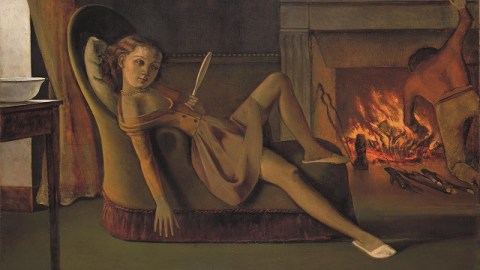Is Balthus the “Crazy Cat Lady” of Modern Art?

When London’s Tate Gallery asked the French painter Balthus for some personal details to include in a 1968 retrospective exhibition, Balthus replied via telegram: “No biographical details. Begin: Balthus is a painter of whom nothing is known. Now let us look at the pictures. Regards. B.” But how do you look at an exhibition such as the Metropolitan Museum of Art’s Balthus: Cats and Girls—Paintings and Provocations and not ask who this man and artist was? Cats may slink around the paintings, but the real provocation in the show’s title comes from Balthus’ long-controversial portraits of young, pre-teen girls, who pose with a mixture of feline grace and tweenage awkwardness that results in, if not child pornography, at least erotic unease for the viewer. Often cats appear as the only on-canvas observers of these models—wide-eyed voyeurs that might serve as stand-ins for the artist himself, whose life-long fascination with cats remains the one personal detail he freely shared. Is Bathus modern art’s “crazy cat lady”—the eccentric whose harmless obsessions taken to the extreme reveal a darker, psychological truth?
Balthus’ career and even his name begin with cats. The 11-year-old Balthasar Klossowski drew 40 pen-and-ink pictures in 1919 of a stray cat he took in named Mitsou. When family friend Rainer Maria Rilke, the renowned German poet and art connoisseur, saw the drawings, he used his contacts to get them published as a book titled Mitsou and even wrote a preface. The young artist’s father suggested that his son’s name be put on the cover as “Baltusz,” a nickname for Balthasar. Rilke, who became Balthus’ mother’s lover and a father figure to the artist after his parents’ separation, encouraged the artist to use the name from then on, which he eventually changed slightly to “Balthus.”
Balthus’ father, Erich Klossowski, worked as an art historian and steeped the young artist in the whole history of art, as well as introduced him to artists such as Pierre Bonnard and Maurice Denis. Balthus’ mother, Elisabeth, herself painted, signing her works as “Baladine” and, perhaps, influencing young Balthus’ choice of a one-word signature. Baladine inspired Rilke to throw off his depression-driven writer’s block and compose his two great late masterpieces, the Duino Elegies and the Sonnets to Orpheus, so Balthus certainly grew up in the fertile environment for an artist.
Cats and Girls more than lives up to the title. Starting with the early Mitsou drawings (once thought lost and on public display for the first time ever), the curators follow Balthus’ twin obsessions through 35 paintings encompassing his career up until 1959, although he continued to paint young models up to his death in 2001. (Another exhibition at New York’s Gagosian Gallery displays the photographs the elderly Balthus took of young girls as studies for paintings when he could no longer draw figure studies.) The provocation found in these paintings doesn’t ever reach the level of Balthus’ most controversial painting, 1934’s The Guitar Lesson, in which the teacher (who bears a striking resemblance to Balthus himself) bends his young female student backwards over his knee and fondles her bared lower body. Perhaps Balthus learned a lesson from The Guitar Lesson that he needed to take a less obvious approach, but could still indulge his fascination with young girls on the cusp of realizing their female sexuality.
Part of that less obvious approach involved the mediating presence of cats. In 1935, the 27-year-old Balthus painted The King of Cats, a bold self-portrait in which a tiger cozies up against his right knee. The King of Cats shows Balthus as a self-confident artist, but also shows him as a dominating figure—the king of his own sensuous jungle. A year after crowning himself king, Balthus began painting Thérèse Blanchard, an 11-year-old neighbor of his in Paris. For the next three years, Balthus painted 10 different portraits of young Thérèse in various settings, sometimes alone (often daydreaming), sometimes with cats, and sometimes with her brother, Hubert. Balthus made his money during this time primarily taking portrait commissions, so spending time with his young neighbor painting for himself must have been the highlight of his day. As the Met’s press release relates, “In Balthus’s work, all of the girls who play with cats peer into mirrors, read, daydream, or appear completely self-absorbed. Their ostensibly unself-conscious postures sometimes suggest sensuality and languor, sometimes ungainliness—a contradiction that is perfectly in keeping with the phenomenon of puberty.” The self-absorption of his sitters mirrored Balthus’ own self-absorption in studying the paradoxes of puberty and adult responses to it (including his own).
The Golden Days (shown above), painted between 1944 and 1946, captures one of Thérèse’s successors in a similar pose. (Thérèse Blanchard sadly died in 1950, only 25 years old.) The young girl lounges on a chair peering at herself in a mirror as a young boy tends to the fireplace behind her. Her dress falls from her right shoulder and leaves her long legs mostly bare, exposing a great deal of skin, but she seems as unaware of those details as she is of the boy or you, the viewer. She narcissistically stares into the mirror, admiring her own youthful beauty. These are The Golden Days free of shame, before Eve and the apple, before the fig leaf of decorum covered over the realities of human sexuality. The model stretches out like a self-satisfied, un-self-aware cat. In 1949, a few years after painting The Golden Days, Balthus painted another cat-related self-portrait, The Cat of La Méditerranée, in which he himself becomes a cat, excited and satisfied by a rainbow of fish landing on the plate before him. A long-haired, topless girl clad only in a skirt rows a boat behind this Cat-Balthus and waves to the viewer (who originally would have been patrons of La Méditerranée, a restaurant). The rainbow transforming into fish almost emerges from the sea-going girl’s head. Picking from a long menu of possible readings, it’s not too much of a stretch to see how one obsession (young girls) fed another (cats).
But is Balthus really going too far in depicting the sexuality of young girls? Mary Cassatt’s Little Girl in a Blue Armchair (1878) shows the same subject in almost an identical fashion (replacing the cat with a sleeping dog), but even those who recognize the sensuality of Cassatt’s approach never question her motives or morality. Are women the only artists who can venture into this uncharted territory of early female sexuality? Balthus never faced the legal charges of pornography that Egon Schiele encountered over his female nudes, but accusations of child pornography have been leveled over the years by the public. The Met’s might be walking a moral tightrope in showing these paintings and even using their provocative nature as a marketing tool, but perhaps the very fact that an establishment venue such as the Met would showcase Balthus in this way is proof that the art world not only finally “gets” what Balthus was trying to do, but also thinks it can convey that message to the public. When David Bowie interviewed Balthus in 1994 (one of the few interviews the artist allowed), Bowie came away calling Balthus “The last legendary painter.” Just as people didn’t initially accept Ziggy Stardust and his spiders from Mars but now revere (and even make museum exhibits about) Bowie, perhaps Balthus the “crazy cat lady” doesn’t seem so crazy anymore.
[Image:Balthus (Balthasar Klossowski) (French, 1908–2001). The Golden Days, 1944-1946. Oil on canvas. 58 1/4 x 78 3/8 in. Hirshhorn Museum and Sculpture Garden, Smithsonian Institute, Washington DC. Gift of the Joseph H. Hirshhorn Foundation, 1966. © Balthus.]
[Many thanks to the Metropolitan Museum of Art for providing me with the image above and other press materials related to Balthus: Cats and Girls—Paintings and Provocations, which runs through January 12, 2014.]





